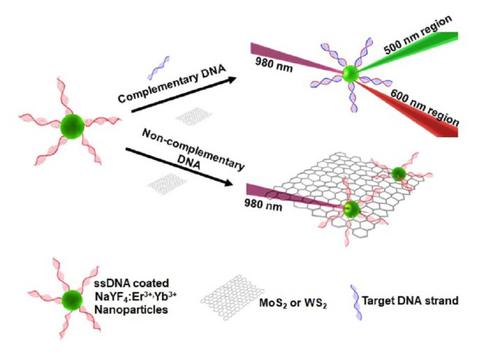Frontiers of Chemical Science and Engineering ( IF 4.5 ) Pub Date : 2021-02-10 , DOI: 10.1007/s11705-020-2023-9 Konstantina Alexaki , Davide Giust , Maria-Eleni Kyriazi , Afaf H. El-Sagheer , Tom Brown , Otto L. Muskens , Antonios G. Kanaras

|
We demonstrate the fabrication of a new DNA sensor that is based on the optical interactions occurring between oligonucleotide-coated NaYF4:Yb3+;Er3+ upconversion nanoparticles and the two-dimensional dichalcogenide materials, MoS2 and WS2. Monodisperse upconversion nanoparticles were functionalized with single-stranded DNA endowing the nanoparticles with the ability to interact with the surface of the two-dimensional materials via van der Waals interactions leading to subsequent quenching of the upconversion fluorescence. By contrast, in the presence of a complementary oligonucleotide target and the formation of double-stranded DNA, the upconversion nanoparticles could not interact with MoS2 and WS2, thus retaining their inherent fluorescence properties. Utilizing this sensor we were able to detect target oligonucleotides with high sensitivity and specificity whilst reaching a concentration detection limit as low as 5 mol·L−1, within minutes.
中文翻译:

基于上转换纳米颗粒和二维二卤化钴材料的DNA传感器
我们展示了一种新的DNA传感器的制造,该传感器基于寡核苷酸包覆的NaYF 4:Yb 3+ ; Er 3+上转换纳米粒子与二维二卤化碳材料MoS 2和WS 2之间发生的光学相互作用。单分散的上转换纳米粒子被单链DNA官能化,使纳米粒子具有通过范德华相互作用与二维材料表面相互作用的能力,从而导致随后的上转换荧光猝灭。相比之下,在互补寡核苷酸靶标的存在和双链DNA的形成下,上转换纳米颗粒无法与MoS 2相互作用和WS 2,从而保留其固有的荧光性质。利用该传感器,我们能够在数分钟内以高灵敏度和特异性检测目标寡核苷酸,同时达到低至5mol·L -1的浓度检测极限。



























 京公网安备 11010802027423号
京公网安备 11010802027423号